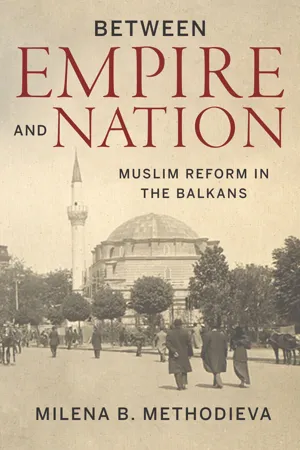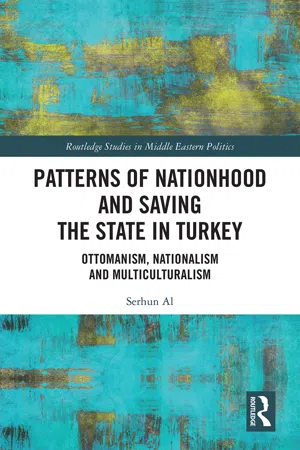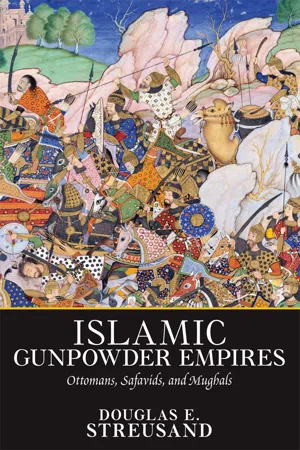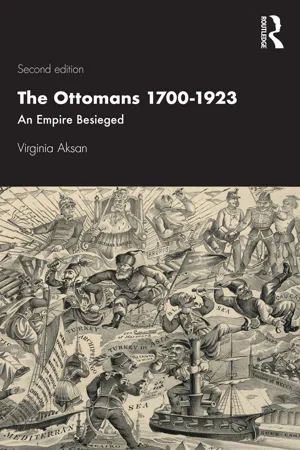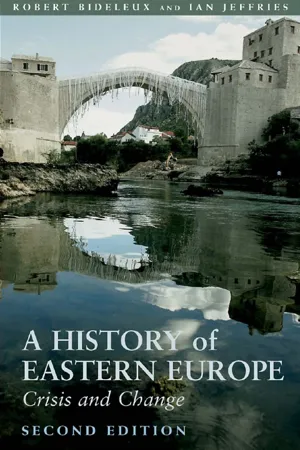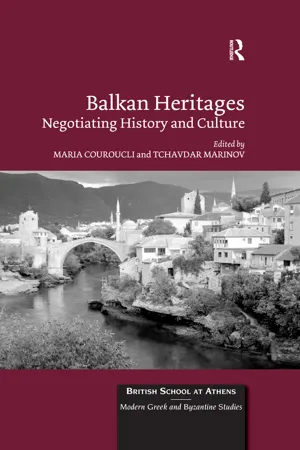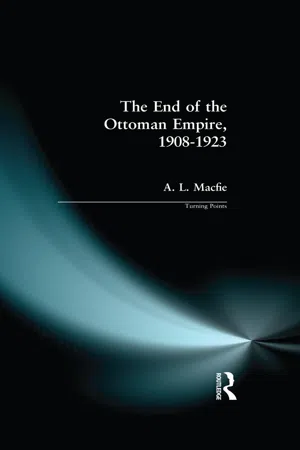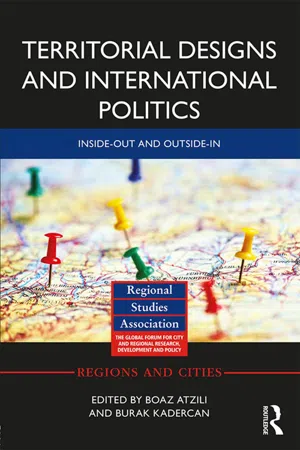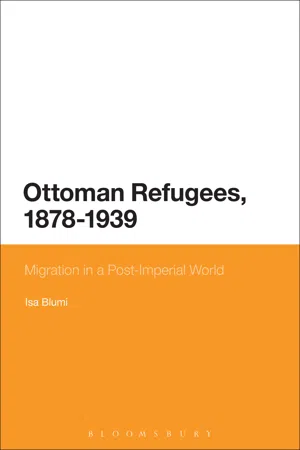History
Ottoman Empire in the Balkans
The Ottoman Empire's presence in the Balkans, spanning from the late 14th century to the early 20th century, significantly shaped the region's history. The empire's rule brought about cultural, religious, and administrative changes, leaving a lasting impact on the Balkan states. The Ottoman Empire's influence in the Balkans ultimately declined due to a combination of internal strife, external pressures, and nationalist movements.
Written by Perlego with AI-assistance
Related key terms
11 Key excerpts on "Ottoman Empire in the Balkans"
- eBook - ePub
Between Empire and Nation
Muslim Reform in the Balkans
- Milena B. Methodieva(Author)
- 2021(Publication Date)
- Stanford University Press(Publisher)
1 The Ottoman Imperial Context Ottoman Rule in the Balkans and the Formation of Muslim Communities The Balkans had only sporadic contacts with Islam and Muslims prior to the fourteenth century. From the eighth century onward, the Byzantines felt the growing military pressure of Arab armies, which besieged the capital Constantinople twice. In the thirteenth century a group of Seljuk Turks seeking refuge in the Byzantine domains were resettled in the area between the Danube delta and Varna. Those who stayed permanently converted to Christianity, setting the beginning of the Gagauz community. 1 Turkish mercenaries also served in the Byzantine civil wars. Yet, it was the Ottoman conquest of the region that brought it into more extensive contacts with Islam and led to the permanent establishment of Muslim communities. The Ottoman state emerged from a small Turkoman principality, or beylik, in northwestern Anatolia. It was one of many such entities that sprung up in the area following the movement of Turks from Central Asia from the eleventh century onward and the dissolution of the Seljuk Empire that had displaced the centuries-old Byzantine supremacy. The people of these principalities were predominantly nomads-pastoralists, but at the same time they engaged in a particular kind of warfare, gaza, fueled by religious fervor and the prospects of booty. 2 The start of the rule of Osman in 1299 is usually taken as the birth of the Ottoman state, although it would take a while for the modest principality to turn into a large empire. Being conveniently located next to the rump of the Byzantine domains, Osman’s people launched upon steady expansion at the expense of the ailing empire and some of their Muslim gazi neighbors. Along the way they attracted more followers. In 1354 under the leadership of the second ruler, Orhan, the Ottomans gained a foothold on the Gallipoli peninsula; from there they made their way into the Balkans - eBook - ePub
Patterns of Nationhood and Saving the State in Turkey
Ottomanism, Nationalism and Multiculturalism
- Serhun Al(Author)
- 2019(Publication Date)
- Routledge(Publisher)
As the empires stayed away from top-down social engineering projects of forming one national community and uniformity of rule, the possibility of managing diverse populations through conquest and expansion became the engine of imperial survival for centuries until the idea of nationalism and popular sovereignty was born on the European continent. Overall:Unlike nation-states, empires were or learned to be less committed to constructing an encompassing collective or to making political relations uniform. Moreover, empires did not have constitutions to regularize rights until they moved into a mixed political mode between empire and nation-state. It was the diversity of peoples, communities, and territories, as well as the diversity of rule, that made empires.7Accordingly, the story of the Ottoman imperial system was not unique despite its distinct sociocultural and religious amalgamation that formed the Ottoman way of ruling over and managing diversity. In this chapter, I first introduce a general depiction of the political and sociocultural foundations of the Ottoman imperial system. Then, I explain the historical context of the state of the late Ottoman imperial structure that was subject to a comprehensive reform project in the nineteenth century. Finally, I briefly narrate the domestic and international processes within which the transition to the foundation of the Turkish Republic took place in the first quarter of the twentieth century. The goal of this chapter is to briefly present the historical context of the broader political and sociocultural trends within which the cases under study were incarnated. By doing this, the study of specific cases in the further chapters can be historically situated in the broader sense.The philosophical foundation of the Ottoman Empire
Founded in 1299 near western Anatolia by a tribal family under the leadership of Osman Bey,8 the House of Osman as the Ottoman state managed to survive, expand, and rule over transcontinental regions of the Balkans, Middle East, and North Africa for more than six centuries until its demise in 1923. The empire functioned as the vanguard of Islam that “the political legitimacy of the Ottoman state was based on its ability to defend the ummah and maintain its welfare within the Abode of Islam.”9 The concept of justice was at the center of the imperial foundation of the Ottoman state that emphasized law and order rather than equality. Status quo—in which each community was expected to remain in their own borders and not trespass on the rights of others—“entailed a basically conservative political outlook, in which any change in the social order had negative connotations.”10 - eBook - ePub
Islamic Gunpowder Empires
Ottomans, Safavids, and Mughals
- Douglas E. Streusand(Author)
- 2018(Publication Date)
- Routledge(Publisher)
Chapter 3 The Ottoman EmpireT he Ottoman Empire’s long history, large size, and pivotal location offer multiple angles of approach to historians. Western historians have commonly seen the Ottomans as an alien threat, part of the Turkic third wave of Islamic aggression against Christendom. From the perspective of Islamic history, it was part of the second political and cultural flowering of the Islamic world. From a geographic perspective, it appears as a reassertion of the imperial pattern of the Eastern Roman (Byzantine) Empire. Fernand Braudel considers the Ottomans part of a unified and coherent Mediterranean region. Arab historians, like the Europeans, regard the Ottomans as intruding aliens. Each of these views of the Ottomans has an element of truth. The Ottomans carried the traditions and conflicts of the post-Abbasid Turko-Irano-Islamic political matrix into the fertile ground—literally and figuratively—of western Anatolia and the Balkans. Its geographic setting, the specific circumstances of its development, the quality of its leadership, its institutional development, and its military organization permitted the Ottoman polity to overcome the chronic weaknesses of post-Abbasid political formations and establish an enduring and extensive empire. The Ottomans integrated themselves into the political and economic environments of Europe and the Mediterranean.For more than two generations, most historians have accepted the view of Paul Wittek that the Ottoman state, from beginning to end, had one primary reason for being: ghaza , which Wittek does not distinguish from jihad. Heath Lowry has recently demolished the Wittek thesis and discredited much of the scholarship behind it. As explained in chapter 2 , frontier ghaza did not coincide with the legal concept of jihad. Even after a more formal and legal conception of ghaza - eBook - ePub
The Ottomans 1700-1923
An Empire Besieged
- Virginia Aksan(Author)
- 2021(Publication Date)
- Routledge(Publisher)
Populations in such loosely governed lands developed their own survival skills that depended on kinship and/or warrior bands and settlements that could make most use of the fluidity and fragility of multiple forms of governance. From the distance of several centuries, it is hard to imagine on the one hand, the intensity of the closeness of isolated communities, and on the other, the fluidity of pastoral nomads or roving rapacious bands. The appearance of an army in full regalia—the empire on parade with the sultan at its head—must have been heard hours before its arrival, and terrifying in its beauty and destructiveness. Süleyman ruled from Istanbul as the shadow of God on Earth, sovereign of three continents, including Mecca and Medina, and as caliph of the Muslim populations of the world, making the Ottomans a global phenomenon. Europeans were terrified, some dazzled, by an empire that welcomed all, renegades and/or aristocrats, by a simple matter of conversion to Islam. Others scorned a system built on slavery and lack of inherited status. The benefits for those who styled themselves Ottomans were enormous. The Ottoman ethos embraced the notion of a family, often referred to as a political household, the largest being that of the sultan himself. His beneficence began with his loyal sons, the Janissaries, and extended to the smallest peasant, his flock (reaya), who had the right of appeal to sultanic justice. The legitimacy of the Ottoman dynasty rested on its adherence to Islamic law, the shar‘ia, justified by the seal of approval of the Ottoman chief religious officer (Şeyhülislam); although, in actuality, sultanic writ and common law had long infused the Ottoman legal system. The problem of imperial aims and religious justification was hardly unique to the Ottoman context - eBook - ePub
A History of Eastern Europe
Crisis and Change
- Robert Bideleux, Ian Jeffries(Authors)
- 2007(Publication Date)
- Routledge(Publisher)
In order to gain a fuller and more balanced understanding of the reasons for the military, economic and cultural ‘decline’ and ‘retardation’ of the Ottoman Empire and the Ottoman domains in the Balkans compared with the West and Central Europe, we need to look beyond narrowly institutional and cultural factors. Under Ottoman rule the predominantly Muslim and the predominantly Orthodox Christian areas of the Balkans undoubtedly lagged behind the economic, educational and cultural development of Western and Central Europe, but it does not follow that Ottoman rule was solely or even primarily responsible for this. The predominantly Roman Catholic areas of the Balkans, which were mostly under Austro-Hungarian rule, also lagged behind Western and Central Europe in most respects, although they did develop more vigorously than the Muslim and Orthodox Christian areas. Orthodox Christian Russia also lagged far behind Western and Central Europe, albeit under the strong and independent Orthodox Christian Tsarist regime. In truth, the ‘decline’ and ‘retardation’ of the Balkans and the Ottoman Empire also involved natural and environmentalcum-locational factors which were largely beyond the control of rulers. Partisan historians of the Balkans have neglected or underplayed the role of the ‘politically neutral’ factors which partly exonerate the major human actors, among whom they prefer to apportion ‘blame’.Demographic Contraction
The population of the Ottoman Balkans, having increased during the ‘Pax Ottomanica’ of the fifteenth and sixteenth centuries, allegedly fell catastrophically from at least 8 million in 1600 to fewer than 3 million by 1750, according to some influential estimates (Lampe and Jackson 1982 : 37–8, 48–9; McGowan 1997 - eBook - ePub
- Christopher Catherwood(Author)
- 2008(Publication Date)
- Citadel Press(Publisher)
Strictly speaking, the First World War was also connected to Slavic wishes for independence and the decline of the Austro-Hungarian Empire—and it was the fall of the latter in 1918 that led very directly to the vacuum in Central Europe that caused the Second World War. But had the Ottoman Empire not been in decline for well over a century, losing by 1913 most of the Balkan side of its once vast possessions, there would not have been the Austro-Hungarian seizure of Bosnia-Herzegovina in 1878, and that province’s formal annexation in 1908—and thus no First World War, which began in 1914 in the Bosnian capital of Sarajevo with the assassination of the Archduke Franz Ferdinand, heir to the Austro-Hungarian throne. So I think my overall analysis is still quite safe!There is a tendency among Western Europeans to think that the end of religious warfare against Islam ended with the Crusades. Those living in eastern and southeast Europe will swiftly disabuse one of such a mistake. For them, the five centuries and more of the suffering of their ancestors was only just beginning, from the first Ottoman incursion into the Balkans in 1354, all the way down to the final liberation of that peninsula from alien rule in 1913, no less than 559 years later.To simplify things geographically in this book, I am going to look at the Ottoman Empire in two ways: first here, in an overview, and then in “The Poetry of Genocide,” a separate chapter on later Balkan history, from the eighteenth century onward, since the fighting there, while linked to the bigger Ottoman picture, had ramifications in the former Yugoslavia in the 1990s that should, for the sake of simplicity, be handled apart from the other present-day result of the Ottoman Empire—Israel, Palestine, and the current war on terror. Inevitably there will be a small measure of overlap, but I think that to have two chapters with differing themes is an easier way to approach the topic than a straight chronology, which could get confusing and overlong. - eBook - ePub
Balkan Heritages
Negotiating History and Culture
- Maria Couroucli, Tchavdar Marinov, Maria Couroucli, Tchavdar Marinov(Authors)
- 2017(Publication Date)
- Routledge(Publisher)
In the context of the Balkans, while repeatedly emphasising Turkey’s support for member states’ accession to the EU as well as membership of all other important international bodies, Davutoğlu has warned about the historical frequency of ‘international rivalries and outside intervention’ in the region (2009a). Through these various themes which Turkey has used to regionalise the Balkans in its own geopolitical image, it has sought to construct and privilege an image of the region that stresses Turkey’s natural membership and sees it as ‘by default and definition a Balkan country’ (Koru 2013), in contrast to the traditional view of ‘the Turk’ as the main ‘Other’. To that end, its discourse has often proffered the Ottoman past as a shared resource that can enable mutual dialogue, understanding and regional identification. Naturally, if accepted and internalised by others, this re-imagination would be a significant source of symbolic capital and would bestow a sense of regional primacy and inclusion upon Turkey as well as redressing the negative image of the Ottoman legacy in the Balkans (Anastasakis 2012: 189). It is worth here emphasising the constructivist emphasis in international relations literature on regions and regionalism as dynamic, fluid and contested processes of spatial relations (Söderbaum 2005: 91). Thus, as Bechev argues, regions and regional identities, rather than constituting self-apparent and given entities, should be seen as particular sociocultural constructions and need to be seen in terms of their ability either to include or to exclude specific actors (2006: 6). In that sense, Turkey’s struggle to integrate itself as a regional member of the Balkans is also a struggle to contest and renegotiate its exclusion and ‘othering’ for the purposes of shoring up its normative claim to membership of the European community of member states. In this context, Davutoğlu argued that all countries in the Balkans, including Turkey, ‘form one family bound by dense societal and cultural ties’ (2011a: 6).However, this project has also been strongly opposed by many of the traditional Balkan member countries, where Turkey’s energetic activism in recent years has not just raised eyebrows but incurred significant resentment and suspicion, especially at the popular level, due to the frequent references to Ottoman rule. Serbian intellectuals, for instance, have strongly challenged this discourse and Turkey’s renewed regional engagement, interpreting it as a sign of Turkish expansionist ambition (Öktem 2010b: 172). This has been the reaction particularly in countries, like Serbia, where the resistance struggle against Ottoman imperial rule is a key element of the nationalist foundation myth (Dijkink 1996: 113–14). Therefore, Turkey’s appropriation of its Ottoman legacy as an ideational source to gain symbolic capital in its quest for regional leadership is strongly contested and disputed. Moreover, one can argue that the sometimes heavy handed insistence on adopting a revisionist version of the Ottoman period in the Balkans has been counter-productive for Turkey, damaging its aspirations to attain regional membership. Finally in this context, the growing authoritarianism of Turkey’s AKP government in recent years, with its harsh repression of the 2013 Gezi protests, widely publicised accusations of corruption extending to the highest government levels and crackdowns on civil society and civil liberties, has damaged Turkey’s international standing and considerably weakened its claim to constitute a model of democratic governance and vibrant economic growth. Meanwhile, as noted above, Turkey’s foreign policy outlook seems unable to deal with the growing turmoil of the Syrian civil war on its doorstep. This could be a sign that Turkey’s resort to the notion of the ‘imperial paradigm’ in its foreign policy may be on the wane. - eBook - ePub
- Alexander Lyon Macfie(Author)
- 2014(Publication Date)
- Routledge(Publisher)
Middle Eastern Studies , Vol. 14, No. 1 (1978).On balance then, the social and economic effects of the Balkan Wars on the Asiatic parts of the Ottoman Empire were somewhat less than might have been expected; but it could not be expected that so profound a disaster would leave the empire unchanged. On the contrary, it soon became evident that substantial changes in the government, politics and ideology of the empire would ensue - changes which would in due course lead to a CUP seizure of power, the suppression of the remaining opposition groups, and a radical shift in the balance of Ottoman ideology, away from Ottomanism and the principle of equality on which it was supposedly based, and in favour of its great rivals, Turkism, pan-Turkism and pan-Islamism.The Bab-i Ali coupThe most immediate effect of the Balkan Wars on the politics of the Ottoman Empire was the seizure of power carried out by the CUP in the so-called Bab-i Ali coup of 23 January 1913. At the time it was widely believed that the Bab-i Ali coup was a spontaneous action, initiated at the last moment by a group of CUP officers, led by Enver, to prevent an Ottoman surrender of Edirne, sought by the Great Powers. According to this account Kiamil Pasha had, following the cancellation of the armistice of 3 December 1912, agreed to dispatch a delegation to discuss peace at a conference to be held in London. In response to demands, put forward by the delegations representing the Balkan states at the conference, that in return for peace the Ottomans cede not only all of the conquered territories in Europe, but also the Aegean islands, the Ottoman delegation had countered with an offer to cede all of the conquered territories in Europe, except Edirne, Albania (which would become an autonomous province, ruled over by an administration to be appointed by the powers) and Macedonia (which would become an autonomous province, ruled over by a member of the Ottoman royal family). These proposals the Balkan powers had rejected out of hand. As a result Sir Edward Grey, the British foreign secretary, who chaired the conference, had proposed that the empire agree to cede all the territories lying to the west of a line running from Enos on the Aegean to the Midia on the Black Sea, a proposal which would have entailed the loss of Edirne. This proposal too the Ottomans were unwilling to accept; but they replied that they would accept it, on condition that Edirne remain part of the empire and that the territories between Edirne and the Dardanelles be formed into an independent principality, which might remain neutral and constitute a buffer zone, protecting the Straits from a possible Bulgarian attack. As a result, during the following days a rumour spread throughout the army that the government intended to accept the loss of Edirne; and on 23 January 1913 a band of disgruntled CUP officers, led by Enver, accompanied according to one account by some 40–60 people, ‘mostly of the hooligan class’, assembled outside the Porte, where the telephone lines had been cut and the guard suborned.5 Enver and his companions then forced their way into the cabinet room and compelled Kiamil Pasha, the grand vizier, to resign. In the process, Nazim Pasha, the minister of war, who came out to see what the noise was, was shot (by Yakub Djemil, the noted CUP fedai) , as were a number of guards who attempted to prevent the intrusion.6 - eBook - ePub
Territorial Designs and International Politics
Inside-out and Outside-in
- Boaz Atzili, Burak Kadercan, Boaz Atzili, Burak Kadercan(Authors)
- 2018(Publication Date)
- Routledge(Publisher)
This spatial categorization suggests that the Ottomans did not think of the global territorial order in binary terms defined as spaces of war versus spaces of Islam, but were cognizant of the grey zones (with many shades of grey, that is) that were not amenable to religion-defined homogeneity. As will also be discussed, this macro-geopolitical perspective suggests that the Ottomans were intentionally trying to create lands of stability in areas where they conquered or were thinking of conquering down the road. This perspective is also compatible with their approach to territory in practice, which was built on a great deal of flexibility and pragmatism.(2) Territorial heterogeneityAs mentioned above, until the nineteenth century, the Ottoman Empire’s territorial design was built on flexible boundaries and a system of heterogeneous management with respect to the space–society–politics nexus. The flexibility and heterogeneity, in so many ways, were a function of the origins of the Ottoman institutions and the make-up of the populations they ruled.While the Ottomans are usually depicted as primarily an Islamic empire, the Ottoman imperial system evolved or ‘was derived’ from numerous sources including the Byzantine Empire as well as Turkic and nomadic traditions, not to mention previous Near Eastern models of administration (Agnelov, Batsaki, & Bazzaz, 2013; Yurdusev, 2004, p. 17). Such diversity in design is not surprising given the temporal and spatial extent of the empire. In the words of Gocek (2013, p. 74), ‘[The Ottoman Empire’s] temporal reign traversed the modern and pre-modern eras, and its geographical land mass covered parts of Eastern Europe, the Balkans, Asia Minor, the Arabian Peninsula, and North Africa.’ The complexity of the Ottoman institutions only increased with further expansion, as the empire ‘became increasingly heterogeneous as it spread over three continents’ (Karpat, 1977a, p. 2).The population over which the Ottomans ruled was also considerably diverse. Even Asia Minor, which is today highly homogenous with respect to religious and ethnic dimensions (thanks to the population transfers of the twentieth century) and usually accepted as the Turkish homeland, was marked by high levels of ethnic, religious, and sectarian differences. Such diversity and the mixed settlement of different social groups made it impractical, or at least very difficult, for the Ottoman state to impose a homogenous administrative and political system within their domain. - eBook - ePub
Ottoman Refugees, 1878-1939
Migration in a Post-Imperial World
- Isa Blumi(Author)
- 2013(Publication Date)
- Bloomsbury Academic(Publisher)
Among other interested parties, Greece, Italy, and Austria appear to have operated within a context of multiple loyalties and political alliances. What such conditions and varied resources did for those Ottoman refugees living in Egypt was just as much a question of personal ambition and growing opportunity as it was one of new collective identities for Albanians, Greeks, or Arabs/Yemenis. In this respect, one other aspect discussed here takes on special significance—namely the experience of the ontological outsider. There is no doubt that the refugees who resettled in the countries neighboring the Kosovo, Yanya, Manastır, and Yemen provinces experienced a certain associational trauma that shaped their political horizons for the rest of the Ottoman period. Like the Ottoman Empire, the ruling classes of the Ottoman state’s imperial neighbors sought to structure societies that enacted unitary cultural and socioeconomic identities. The consequences for those identified as outsiders have been devastating over the course of the twentieth century.All this must be read in the larger context of diasporic theory that has emerged in the past few years. It can be argued that the entire project of the modern state identified in these locales of exile employed technology and the self-aware institutions of state power to control diversity, develop uniformity, and, in the process, criminalize or anathematize the strangers within. In no time, European “reforms” in the Balkans imposed institutional structures and rhetorical tools that grounded local politics to reflect exclusively a secure triangulation of territory linked to identity. This would be an identity based on the ethno-national marker (often with a sectarian foundation) and the state. This rigidification of political possibilities took place inspite of the same agents of imperial policy in Arabia and the Balkans who understood that people were eminently mobile, and that the boundaries within which they operated had always been in flux.97I suggest that, to the contrary of most assumptions about this modernization process, even as the structure of the “modern” person was being built and imposed along an axis of enforced inclusion/exclusion. But this would necessarily be a violent process. The experience of the outcast, noted here in its many forms, could not be so neatly contained. It is apparent with the cases of the resettled Ottoman refugees in Romania, Bulgaria, and Egypt explored above that locals had their own shifting notions of these markings of “modern” communal identity. The more that local turmoil directly affected the ability of local stakeholders to endure, new channels of survival, including trade and exclusionary rhetoric, were sought.98 - eBook - ePub
Shatterzone of Empires
Coexistence and Violence in the German, Habsburg, Russian, and Ottoman Borderlands
- Larry Wolfe, Gregor Thum, Dan Diner, Theodore R. Weeks, Gary B. Cohen, Pieter M. Judson, Frithjof Benjamin Schenk, Elke Hartmann, Patrice M. Dabrowski, Robert Nemes, Yaroslav Hrytsak, Tomas Balkelis, Taner Akçam, Eyal Ginio, Keith Brown, David Gaunt, Peter Holquist, Alexander V. Prusin, John-Paul Hi, Omer Bartov, Eric D. Weitz, OMER BARTOV, ERIC D WEITZ(Authors)
- 2013(Publication Date)
- Indiana University Press(Publisher)
This chapter aims to explore the development of an excluding discourse in the policy of the Ottoman Empire toward its non-Muslim populations, as it appeared in the press, in the memoir literature, and in various other publications during the Balkan Wars and their aftermath. I will argue that Ottoman policy toward its minorities at the outbreak of hostilities in October 1912 began to take a very different path, as we will see clearly after first looking at the relatively inclusive discourse (and practice) that prevailed with regard to the non-Muslims in the Ottoman nation during the first weeks of the first Balkan War. After briefly demonstrating this, I will present the narratives of total rout that quickly appeared during and following the first Balkan War and their emphasis on the role assigned to the non-Muslims (mostly Greeks and Bulgarians) in the military debacle and the ensuing atrocities against local Muslim populations. I will show how these narratives contributed to the singling out of non-Muslims as traitors and to their subsequent exclusion from the imagined Ottoman nation. These changes, I will argue, make the Balkan Wars the true watershed in the way the Ottoman state perceived its non-Muslim populations. The first who suffered from this new exclusionist approach were the Christians who inhabited the European area later known as eastern Thrace that remained under Ottoman sway following the Balkan Wars. It was in these borderlands that Ottoman non-Muslims fell victim to a nascent nationalist movement that perceived them as aliens and as a threat on the national community and its cohesion.Eastern Thrace as a Borderland
The mostly flat area of eastern Thrace was the major front of the Balkan Wars. Known to contemporaries as the “Eastern Front,” it separated Bulgaria from the Ottoman capital of Istanbul. Indeed, in Thrace it was mainly the advancing Bulgarian Army that bore the brunt of the fighting against the Ottoman Eastern Army. Following the outbreak of hostilities in this area on 18 October, the first major military encounter took place in Kırkkilise (Kırklareli). Over the course of three days (22–24 October) the invading Bulgarian army fought the Ottomans along a 36-mile front stretching from Kırkkilise to Edirne. Suffering from heavy casualties and the loss of military equipment, the demoralized Ottoman army hastily retreated. After a few days’ break in the hostilities the two armies met again in Lüleburgaz. Following a four-day battle (29 October–1 November) in which the Bulgarian attack benefited from very effective artillery use, the victorious Bulgarian army was able to further advance as far as the defense line of Çatalca, only 20 miles away from the center of Istanbul.On their way to Istanbul, the Bulgarians were able to lead a siege on the fortified city of Edirne. Under the command of Ferik Mehmet Şükrü Paşa, manned by a garrison of about 52,500 soldiers, and supported by mighty fortifications, the city was able to endure a siege of about five months until its capitulation on 26 March 1913. The Bulgarians were therefore able to establish their control over the whole of Thrace.
Index pages curate the most relevant extracts from our library of academic textbooks. They’ve been created using an in-house natural language model (NLM), each adding context and meaning to key research topics.
